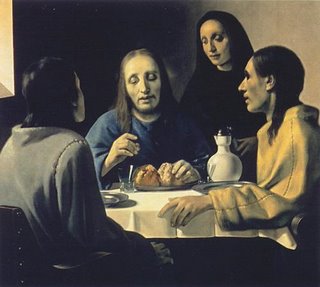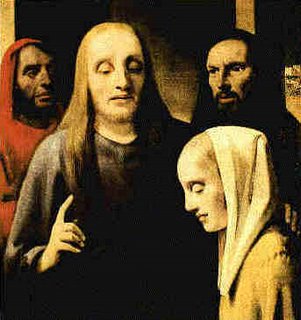On 25 June 1938, as part of the jubilee for the reign of the Dutch monarch Queen Wilhelmina, Rotterdam's Boijmans Museum unveiled an exhibition entitled Four Centuries of Masterpieces 1400-1800. The poster for the exhibition featured a detail from Jan Vermeer's The Supper at Emmaus, a recently discovered painting, donated to the museum after being bought for 520,000 guilders and a work now being widely touted as the 17th-century artist's masterwork.

the Supper at Emmaus
Day after day, one man returned to view Emmaus. Han van Meegeren, also an artist, would stand alongside the awestruck pilgrims and pronounce: 'I can't believe they paid half a million guilders for this. It's obviously a fake.'
Han van Meegeren, would become the most famous forger in history. Born in Deventer in 1889, he was from the start a patently gifted artist, but also a man out of time, painting portraits in the manner of van Dyck when Cubism and Futurism were in vogue. Driven by a desire for revenge, on his dismissal at the hands of the Dutch art critics, he found himself drawn to forgery.
His career began slowly. In 1913, he won the prestigious Hague Gold Medal for his Study of the Interior of the Laurenskerk. Though van Meegeren received no money for the award, the study sold for 1,000 guilders, the equivalent of nearly £3,300 today. Sometime later, a foreign collector contacted van Meegeren and asked if he could buy the picture. Van Meegeren agreed and set to work to create a facsimile, intending to pass it off as the original. Under pressure from his wife, he balked at the last minute. The mathematics were striking: instead of the 1,000 guilders agreed, he was paid just 80.
As gifted as his tastes were unfashionable, it did not take van Meegeren long to see that forgery made financial sense. He plumped for Vermeer, the artist he admired above all others and with whom he felt a bond. Like him, Vermeer - or so he chose to believe - was an artist neglected and wronged by critics and who had died almost unknown. But it was also a canny move; so little was known of Vermeer's life and works that it would be easy to add to the catalogue of accepted work. He started modestly, with a minor genre piece: Lady and Gentleman at the Spinet, described by Wynne as 'forgery by numbers'. Pastiche or not, it was authenticated and sold for 40,000 guilders. With the money, van Meegeren bought his first car, a Dodge sedan.
The forger, writes Wynne, 'must become a skilled art historian, a restorer, a chemist, a graphologist and a documentalist if he is to exploit his talents as a charlatan. It is not a vocation for the indolent'. Now based in the south of France, van Meegeren was keeping himself busy, honing his technique while working on bread-and-butter portraits of the local merchants, expats and musicians. Though he had learnt as a student how to make his own pigments, creating something that would pass as a major 17th-century piece of art, not to mention securing a reputable authentication, was going to be a lot harder.
He devised a paint-hardening method using phenol and formaldehyde and built himself an oven in which, he discovered, it was possible to recreate the distinctive craquelure of 17th-century paintings. Eventually, through an intermediary, The Supper at Emmaus, featuring Christ and his disciples, was authenticated by no less a figure than respected Dutch art critic Abraham Bredius. From there, it was but a short step to the hallowed halls of the Boijmans.
Though he made a fortune from his forgeries his downfall came when he was arrested in 1945 for selling a Vermeer to Reichsmarshall Hermann Goering. When, finally, he admitted that the painting was, in fact, a forgery, the resulting court case turned into a media circus, a forum in which van Meegeren thrived. Here, at last, he got the revenge he thirsted for. As the judge said in his summing-up: 'The art world is reeling and experts are beginning to doubt the very basis of artistic attribution. This was precisely what the defendant was trying to achieve.'

Christ with the Adulteress
For the record the painting that brought about his downfall was Christ with the Adulteress which he sold in 1942 and which changed hands a number of times before it ended up in the collection of Reichsmarshall Göring, The painting was found in an Austrian salt mine by Allied forces, and led to Van Meegeren's arrest. Originally arrested as a collaborator when he told the police that the painting was a forgery, they didn't believe him, and challenged him to show he could paint a copy of one of the supposed fakes. He replied that he could create an entirely new fake.
He was put under house arrest, and in three months he painted a new forgery, The Young Christ Teaching In The Templee. The story got into the press and attracted worldwide media attention. The charge was changed to one of forgery. In the week before the trial, a poll showed he was the second most popular man in the Netherlands, after the prime minister.
He finally came to trial in 1947 and was sentenced to two years imprisonment. Already in ill health van Meegeren was sent to a clinic where he died in December 1947.

A genuine Vermeer
The Art Forgeries of Hans Van Meegeren
The van Meegeren Forgeries
Hans
Meegeren
forger
forgeries
Vermeer
13 comments:
Forgery is an art btw. Who was the other, his name skips my mind - he is a great favorite with the collectors, and the fakes considered as good as the originals.
Forgery is done here at Varad (Oradea) mostly - but they lack talent, utterly.. They are into expressionism
I hate collectors.
I haven't had a chance to read the whole blog entry yet so forgive me for jumping in with a comment anyway, but my girls and I just finished up the best piece of children's literature to come around in a long time.
The book is called, CHASING VERMEER, and it's marvelous. My Grandma came here with her family from Holland, but I still didn't know squat about Vermeer or other Dutch painters until reading this book. It was amazingly clever and not dumbed down like books for kids usually are. My oldest daughter, Lauren, got a chance to meet the author last month and received a signed copy of her new book, "The Wright 3".
We're addicted to Lemony Snicket too and the books share the same illustrator.
We learned that Vermeer was regarded as the first artist to paint ordinary life as opposed to aristocratic subjects, and that he died in abject poverty for all his efforts. Dying in poverty seems to be the secret of success for most painters. I wouldn't recommend it to my children as a profession!
I'll check this out...thanks
Tom Keating was big at one time
"Dying in poverty seems to be the secret of success for most painters"
Hmm. Also legends: after all Mozart did not die in poverty. However, we are delighted whenever a great artist starves. Probably part of the charisma.
If you want a less academic approach, Ealsticwaistband, go and watch "Girl with a pearl earring".
My older girls have actually been bothering me to see that movie, redwine. I'll wait for a PG edited version for them.
Poverty builds memorable legends in the arts, true enough. What about the high number of drug/alcohol afflicted and a touch of insanity that runs through a lot of the more creatively minded too?
My favorite quote from a punny friend of mine at another board was:
"ABSINTHE makes the heart grow fonder" :)
I think that was written in tribute to Oscar Wilde.
It is indeed an art, red. One that does need a hell of a lot of skill. As gernt mentions there was a famous forger here called Tom Keating . He wsa quite a celebrity.
Chasing Vermeer sounds like a great kid's book (I know of Lemony Snicket.. I like the name!)It's good to know that there are good quality children's books out there. I,m glad the the kids liked it.
Ah it is the image of the tubercular artist rotting awway in the garret that catches the imagination.. It sounds perversely romantic but I daresay most would run a mile from such a life themselves!
Perhaps we just liie people to suffer for their art so long as it isn't us!
Ha, jams! you said we like them to suffer for their art. Remember that line from the song, "Vincent", about him struggling for his sanity?
Slicing off your own ear, yeah, that's pretty quirky.
lol I'm not sure quirky describes his action!
Alright jams, I didn't wanna have to do this but read it and cringe:
HOW HE STRUGGLED FOR HIS SANITY INDEED!
A surefire cure for all those teenage boys Turning Japanese!
Why people do things like that I will never know but it is not so uncommon.. the Fortean Times caries frequent stories of people cutting bits off, most notably their members..
Jams: I hope they keep up the good work. I.e. chopping off members. The more the merrier (for me).
Okay Red just for that I will reveal your true identity.. Step forward Lorena Bobbit!
Post a Comment